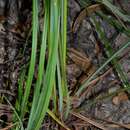Comments
provided by eFloras
Carex joorii is more robust than C. glaucescens and can be distinguished from C. glaucesens and C. verrucosa by the acute apex of the scale body, the strongly veined, squarrose perigynia with low, flattened papillae, and the broadened base of the achene. Occasional specimens have been observed with papillae characteristic of C. glaucescens; such specimens may result from hybridization.
- license
- cc-by-nc-sa-3.0
- copyright
- Missouri Botanical Garden, 4344 Shaw Boulevard, St. Louis, MO, 63110 USA
Description
provided by eFloras
Culms to 125 cm. Leaves: sheaths glaucous, fronts indistinctly veined, veins not persisting, apex thin, truncate or irregularly convex; blades 120 cm × 7–10 mm, glabrous. Inflorescences with 5–7 spikes, 30 cm; peduncle of lateral spikes to 6 cm; proximal bracts equaling inflorescences, 3–6 mm wide; lateral spikes divergent, 3–6 cm × 6–8 mm. Pistillate scales shorter and narrower than perigynia, apex acute, awn to 3 mm. Perigynia strongly divergent, red-brown, angles veined, faces prominently 6–8-veined, sessile, widely elliptic or somewhat obovate, 3.5–4.5 × 2.8–3.2 mm, base rounded, apex ± truncate proximal to beak, densely papillose with low, oblong or, rarely, minute, rounded papillae, not markedly glaucous; beak 0.3–0.5 mm, entire or minutely bidentate, teeth to 0.1 mm. Achenes rhomboid, 2.5–3 × 2.5–3 mm, base conspicuously broadened.
- license
- cc-by-nc-sa-3.0
- copyright
- Missouri Botanical Garden, 4344 Shaw Boulevard, St. Louis, MO, 63110 USA
Distribution
provided by eFloras
Ala., Ark., Fla., Ga., Ky., La., Md., Miss., Mo., N.C., S.C., Tenn., Tex., Va.
- license
- cc-by-nc-sa-3.0
- copyright
- Missouri Botanical Garden, 4344 Shaw Boulevard, St. Louis, MO, 63110 USA
Habitat
provided by eFloras
Seasonally saturated or inundated soils in moist, swampy, or bottomland woods, or stream banks; 0–800m.
- license
- cc-by-nc-sa-3.0
- copyright
- Missouri Botanical Garden, 4344 Shaw Boulevard, St. Louis, MO, 63110 USA
Comprehensive Description
provided by North American Flora
Carex joorii L. H. Bailey, Proc. Am. Acad. 22: 72. 1886
"Carex macrokolea Steud." Rob. & Fern. Man. 247. 1908.
Loosely cespitose, from creeping, stout, tough, blackish, scaly rootstocks, the culms strongly phyllopodic, 4-10 dm. high, erect, stout, exceeding the leaves, sharply triangular and much roughened above, reddish-brown at base, the sterile shoots numerous, phyllopodic; leaves with well-developed blades 8-15 to a fertile culm, on the lower half, the lower bunched, the upper separate, not septate-nodulose, the blades thin but stiff, glaucous, channeled at base, flat with revolute margins above, 2-5 dm. long, 3-10 mm. wide, serrulate-margined and very rough towards the long-attenuate apex, the sheaths very thin and yellowish-tinged ventrally, not filamentose, truncate at mouth, the ligule short; staminate spike one, longrough-peduncled, erect, 1.5-3 cm. long, 3 mm. wide, the scales narrowly oblong-obovate. tapering into a short, rough awn, white-hyaline with green, three-nerved center and slightly reddish-brown-tinged; anthers red, 4 mm. long; pistillate spikes 3-5, approximate or the lowest separate, erect, the lower on rough peduncles shorter or somewhat longer than the spikes, the upper shorter-peduncled to nearly sessile, oblong, 1.5-6 cm. long, 7-10 mm. wide, sometimes sparingly staminate at apex, densely flowered, the perigynia 15-50, squarrose-spreading at maturity in several to many rows; lowest bract slightly sheathing, leaflet-like, from somewhat shorter to longer than inflorescence, the upper much reduced; scales obovate, not retuse, abruptly rough-awned, the body narrower and shorter than the perigynia, hyaline with green 3-nerved center and more or less reddish-brown-tinged; perigynia very broadly obovoid, inflated-suborbicular in cross-section, 4 mm. long-^ 3-3.5 mm. wide, strongly many-ribbed, dull-green, often but slightly glaucous, submembranaceous, tapering at base, sessile, the beak 1 mm. long, flat, conic, straight or slightly bent, the orifice entire; achenes rhomboid-orbicular, rather loosely enveloped, 2.5 mm. long and somewhat wider, triangular with deeply concave sides and blunt somewhat knobbed angles, yellowish, sessile, abruptly apiculate, jointed with the straight, short, thickish style; stigmas 3, reddish-brown.
Type locality: "Comite Swamp, near Baton Rouge, La." (Joor).
Distribution: Hummocks in cypress swamps, Florida to Texas, northward to Maryland, and in the Mississippi Valley to western Tennessee and southeastern Missouri. Flowers in summer. (Specimens examined from Virginia, Maryland, South Carolina, Georgia, Florida, Mississippi, Louisiana, Texas, Arkansas, western Tennessee, southeastern Missouri.)
- bibliographic citation
- Kenneth Kent Mackenzie. 1935. (POALES); CYPERACEAE; CARICEAE. North American flora. vol 18(6). New York Botanical Garden, New York, NY
Carex joorii: Brief Summary
provided by wikipedia EN
Carex joorii, commonly called cypress swamp sedge, is a species of flowering plant in the sedge family (Cyperaceae). It is native to the United States, where it is found primarily in the Southeastern region. Its natural habitat is in the shallow water of depression swamps, often growing with Sphagnum moss. It can also be found in bottomland woods, and in wet prairies.
Carex joorii is a perennial graminoid. It produces fruits in the summer through early fall.
- license
- cc-by-sa-3.0
- copyright
- Wikipedia authors and editors

